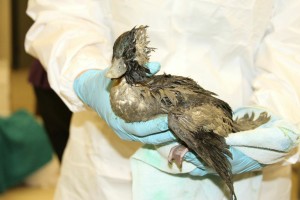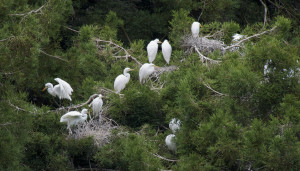A few weeks ago, Cindy Margulis, a volunteer with International Bird Rescue, was watching a snowy egret at a rookery on Bay Farm Island in Alameda.
It’s no surprise that there’d be an egret at an egret rookery, but this turned out to be a special bird — and a lesson in just why researchers put bands on birds in the first place.
“I noticed the band when he flew into a tree [a few feet away] while he was trying to get material to build his nest,” says Margulis. “Typically with nest building, the female selects the site that she wants, but it’s the male’s job to go get her the building materials.”
When Margulis noticed the silver glint on this egret’s leg, she decided to investigate. Over several sightings, she took photos of the bird’s band and was able to piece together the number imprinted on it.
And that was the key to turning just another snowy egret into a small but satisfying success story for International Bird Rescue.
After looking through her own records and then cross-referencing them with official records, she was able to confirm that she had seen this same bird released up the road from Bay Farm at Martin Luther King Jr. Regional Shoreline last year, after it had been rehabilitated at International Bird Rescue’s San Francisco Bay Area Center in Fairfield.
Jay Holcomb, Bird Rescue’s emeritus director, said the group bands every bird that is successfully rehabilitated. “The band is the only clue we have to let us know if our job was done and if we are helping them or not.” And it’s actually not that often that a volunteer manages to spot a rehabilitated bird again in the wild.
This young bird ended up at Bird Rescue’s facility after a local found him on the ground in poor health near a rookery that sits right on a busy street in Santa Rosa.
Bay Farm Island, though not exactly wilderness, is a much better spot for egrets. “I went and saw the snowy egret with Cindy a couple of weeks ago,” said Marie Travers, International Bird Rescue’s assistant center manager. “It was really fantastic to see one of the birds we had rehabilitated back out there and trying to breed.”
Margulis explained that since egrets typically congregate during their spring and summer breeding season, rescue workers released a small group so that together they can acclimate to life in the wild. The egret she spotted probably found his way to the rookery on Bay Farm Island by following other egrets.
Three times a week, Margulis spends one to two hours at the Bay Farm rookery. With her binoculars and spotting scope she has been able to take a closer look at more than 25 egret nests that fill a single pine tree. She says she’s spotted another egret with a band but hasn’t been able to track it to verify whether it might also be one of the birds released on the same day.
The work it takes to save an individual animal “is validated in part by being able to find out how they do and where they are seen after they are released,” said Travers.
Holcomb is the person authorized to band birds at the International Bird Rescue. He logs the band information into an online database, and then submits it to the Bird Banding Lab. Volunteers and citizens who find a bird with a band number can go to the Bird Banding Lab website to fill out an online form and get information about the bird, such as the conditions under which the bird was admitted to the rescue and when it was released.
The International Bird Rescue’s San Francisco Bay Area Center takes in an average of 500 birds a year during the spring and summer and every bird is banded before it is released into the wild.
But only a small percentage of these birds are ever seen and recorded again.
Thanks to Margulis, one snowy egret has turned from a data point of rehab and release into a story of success and survival.

.jpg)



